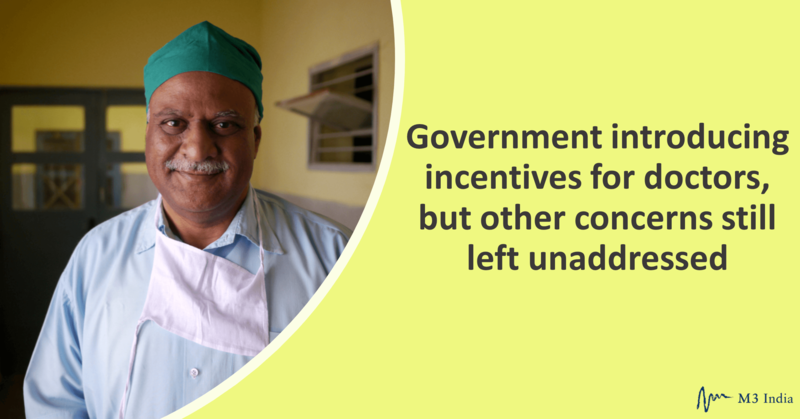Government introducing incentives for doctors, but concerns still remain
M3 India Newsdesk Aug 23, 2019
Doctors in public service in India can boast of job stability and perks like housing and other allowances. And they are truly empowered to serve society and earn the satisfaction and gratitude from treating patients of lower economic backgrounds. But the state of public healthcare can, and does, wear these doctors down.

Hardly 1.5 per cent of India’s GDP is spent on healthcare; by 2025 it is set to increase to 2.5 per cent of its GDP by 2025 but that is still nowhere near enough. According to the National Health Profile 2017, there is one government allopathic doctor for every 10,189 people in India (against a ratio of 1:1000 recommended by WHO), one government hospital bed for every 2,046 people and one state-run hospital for every 90,343 people. These are stats are a damning indication of the pressure that public hospitals and the doctors in them are constantly under.
The Centre, fully cognizant of the brain drain resulting from this, has been continually introducing incentives like the raise in the superannuation age of CHS doctors and dental doctors working under the Ministry of Health and Family Welfare to 65 years, time-bound promotions and expeditious filling of vacancies, longer leave to pursue higher studies/research, training programmes and career-advancing opportunities, non-practising allowance and more days of leave per year. But concerns remain.
- Doctors say that working in a government hospital does not expose them to the latest technological advancements, especially in the field of surgery. So, doctors need to make an extra effort to stay abreast with cutting edge technology but this isn’t helpful if they are not able to complement it with some hands-on experience.
- Government hospitals also struggle with shortage and poor quality of medicines and often doctors are blamed for this. Doctors place orders for medicines based approximately on the headcount of patients but Dr. Neeti Thomas (name changed) explains that sometimes when you place a request for 10,000, you may get only 1000. A doctor serving at a state-hospital, she says even basic medicines like insulin go out of stock and then the hospital receives new medicines only in March every year.
- Another huge concern for doctors is the spectre of job transfers. Dr. Thomas says, “We are eligible for transfers every three years. But the rules differ from state to state. In Karnataka, doctors are given an option to remain in the hospital unless they themselves want to change. However, in Kerala, we have to accept the transfer.” Politics is the reality in any environment, however, from promotions to postings, doctors need to deal with a lot of this at government hospitals which can be taxing.
- Even with stable salaries and hikes, remuneration in public service is much lower than what doctors in private practice make. Many doctors resort to private practice after hospital hours to supplement their income. The shortage of government doctors exacerbates the situation for existing doctors who sometimes have to deal with 300-400 patients waiting for them at the hospital during their allotted four hours of practice.
- Doctors in public service climb the career ladder more slowly. For example, promotions are given out once every five years and in medical colleges, doctors start off as a lecturer, then climb up to assistant professor, associate professor and professor. However, Dr. Thomas explains that now a new Additional Professor post has been created. Promotions are often stalled here for long and full professorship takes much longer to achieve.
Clearly, there is still a long way to go in making the lives of doctors in public service easier. The government needs to invest in bringing the latest technology in state hospitals to allow doctors to give patients the best treatment possible. Remuneration needs to be scaled up and timely promotions should be given out to doctors to inspire and motivate them. All this is possible only with a substantial increase in spending on healthcare to boost the overall state of public healthcare and doctors in our country.
The author, Parvathy Jayakrishnan is a Bengaluru-based freelance writer and a member of 101Reporters.com, a pan-India network of grassroots reporters.
-
Exclusive Write-ups & Webinars by KOLs
-
Daily Quiz by specialty
-
Paid Market Research Surveys
-
Case discussions, News & Journals' summaries